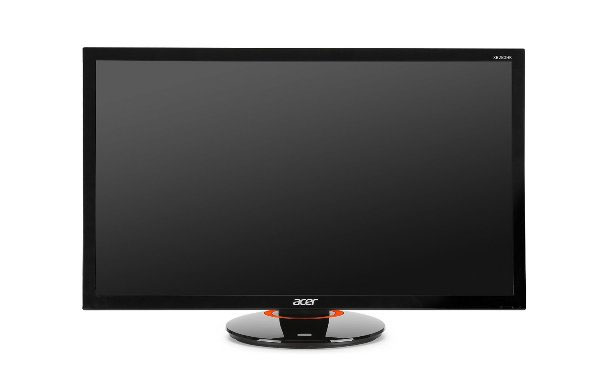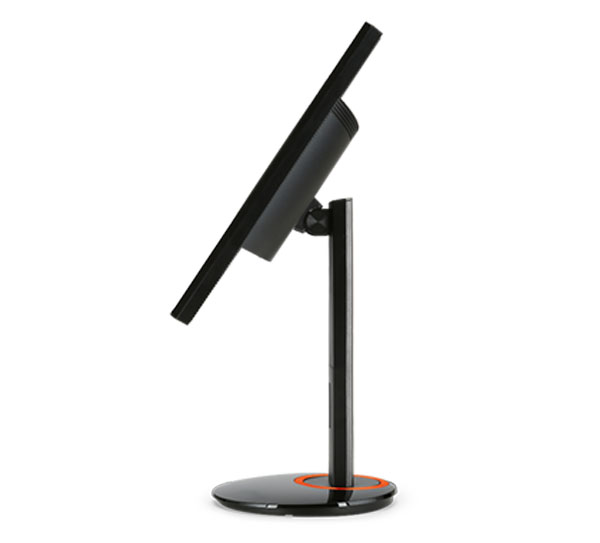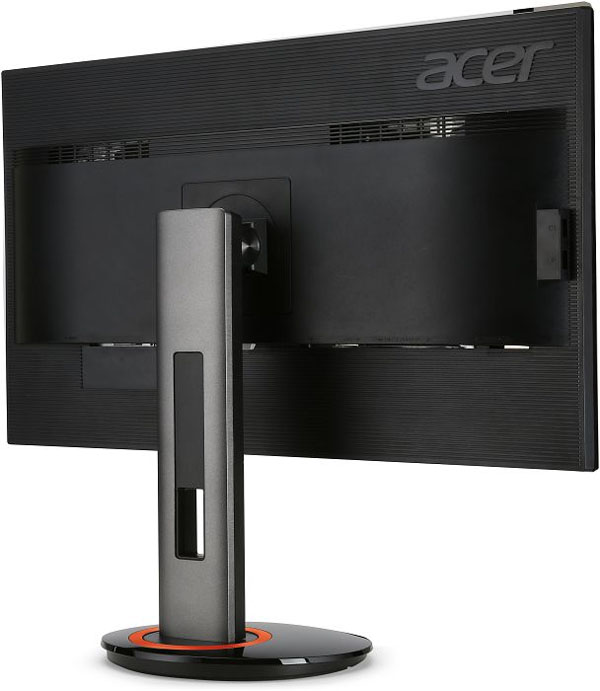Acer XB280HK 28-inch G-Sync Ultra HD Gaming Monitor Review
Acer breaks new ground with its XB280HK. Offering an Ultra HD resolution and G-Sync in a reasonably-priced 28-inch package, this monitor is unique.
Why you can trust Tom's Hardware
Physical Layout
The medium anti-glare screen layer is surrounded by a thin black bezel polished to a high gloss. While a surface like this can pick up reflections, it looks much blacker than the textured surfaces found on most other monitors. A similar piano-black finish is also used on the base, along with a red accent. The whole package looks high-end.
The OSD is controlled with small mechanical buttons in the lower-right. Four keys navigate the menus and one toggles the power, flanked by a bright blue LED. The controls click with a quality feel and respond to just the right level of pressure.
The stand offers full tilt, swivel, height and portrait adjustments. All the movements are firm without too much resistance, yet the panel stays where you set it. At first glance, the bezel looks to be the same width all around. However, it’s three millimeters wider at the bottom. If you want to set up multiple screens in a vertical orientation, take this into account.
The XB280HK’s side profile is fairly slim, dominated by a bulge containing the monitor’s internals. There are two USB 3.0 downstream ports on the left side and slightly behind the edge of the panel.
You can see that there is plenty of ventilation at the top of the bulge around back. This is a cool-running monitor. Its upright contains a small cable management hole for convenience. Acer’s logo is proudly displayed at the top so your opponents will know what you’re running from across the room.
The only video input offered is a lone DisplayPort interface. The XB280HK doesn’t include audio support, so you won’t find any headphone or speaker jacks. You’ll have to route sound from your computer to an external solution. At the far right, you can see the USB 3.0 upstream and two downstream ports. Not shown is the power plug with accompanying master switch.
Get Tom's Hardware's best news and in-depth reviews, straight to your inbox.

Christian Eberle is a Contributing Editor for Tom's Hardware US. He's a veteran reviewer of A/V equipment, specializing in monitors. Christian began his obsession with tech when he built his first PC in 1991, a 286 running DOS 3.0 at a blazing 12MHz. In 2006, he undertook training from the Imaging Science Foundation in video calibration and testing and thus started a passion for precise imaging that persists to this day. He is also a professional musician with a degree from the New England Conservatory as a classical bassoonist which he used to good effect as a performer with the West Point Army Band from 1987 to 2013. He enjoys watching movies and listening to high-end audio in his custom-built home theater and can be seen riding trails near his home on a race-ready ICE VTX recumbent trike. Christian enjoys the endless summer in Florida where he lives with his wife and Chihuahua and plays with orchestras around the state.
-
Frozen Fractal On first glance I thought I wouldn't have to see "we will be reviewing XB270HU soon" quote again. But then I realized it's XB280HK. Oh well, guess have to endure that quote for few more time :rolleyes:Reply
Contrast ratio, brightness, chromacity & gamma tracing is where XB280HK looses the ground, but to be fair, most of the gamers won't be noticing much difference at all. But it is kind of disappointing to see Planar do better in these fields than Acer utilizing the same panel. I don't know, maybe the overdrive somehow worsen the results?
But ofcourse, it does well on uniformity and response time. Makes me wonder why XB280HK doesn't have ULMB if it's supposed to be a bundled feature with G-Sync. That should've helped in 60Hz panels more, rather than 144Hz ones.
But anyway, XB280HK looks promising, although I don't think 4K is what I prefer for gaming+life (although I do for gaming only). -
Frozen Fractal Reply16328127 said:Sorry if i missed it but what version display port is it?
It's 1.2a I presume. Since that's what is capable of 4K@60Hz other than HDMI 2.0 -
boju Should be at least version 1.2 for 4k @ 60Hz since this version has been doing this since year 2009. v1.2a is the same Res/Hz deal but brings added support for Freesync.Reply
-
picture_perfect Why do they keep pushing 4K for gaming. True gamers have always regarded fps as king and 4K is one-quarter the frame rate of 1080. Gamers don't need expensive 4K monitors driven by expensive cards at ever-lower frame rates (via G-sync). This is chasing the proverbial tail and counterproductive. Regular 1080p, v-synced at a constant 144 fps would be better than all that stuff.Reply -
spagalicious ReplyWhy do they keep pushing 4K for gaming. True gamers have always regarded fps as king and 4K is one-quarter the frame rate of 1080. Gamers don't need expensive 4K monitors driven by expensive cards at ever-lower frame rates (via G-sync). This is chasing the proverbial tail and counterproductive. Regular 1080p, v-synced at a constant 144 fps would be better than all that stuff.
*Competitive Gamers
People that like to play games also like to play games in ultra HD resolutions.
-
picture_perfect 4K is cool but GPUs cant handle it well enough yet. I'd rather have 1080p at high fps and gain an extra 1-2 frames of lag, but to each their own.Reply -
bystander Reply16328109 said:But ofcourse, it does well on uniformity and response time. Makes me wonder why XB280HK doesn't have ULMB if it's supposed to be a bundled feature with G-Sync. That should've helped in 60Hz panels more, rather than 144Hz ones.
ULMB uses flickering to lower persistence, which reduces the motion blur. If you've ever used 60hz CRT monitors, you'll know that flickering is painful on the eyes. This is why ULMB mode is not offered on 60hz monitors, and likely won't be offered on anything less than 75-85hz.
-
bystander Reply16329841 said:4K is cool but GPUs cant handle it well enough yet. I'd rather have 1080p at high fps and gain an extra 1-2 frames of lag, but to each their own.
Top end GPU's can handle 4K just fine. You just don't play it at max settings. What is better, medium to high settings and 4K, or maxed at 1080p? That is a subjective question, and will vary from person to person.
That said, I prefer higher refresh rates than 60hz, so I'll be going 1440p before 4K.




